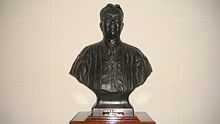Ramón Avanceña
| Ramón Avanceña | |
|---|---|
 | |
| Monument to Avanceña in the Supreme Court of the Philippines | |
| 4th Chief Justice of the Supreme Court of the Philippines | |
| In office April 1, 1925 – December 24, 1941 | |
| Appointed by | Calvin Coolidge |
| Preceded by | Manuel Araullo |
| Succeeded by | José Abad Santos |
| Attorney General of the Philippines | |
| In office 1914–1917 | |
| Preceded by | Ignacio Villamor |
| Succeeded by | Quintin Paredes |
| Personal details | |
| Born | April 13, 1872 |
| Died | June 12, 1957 (aged 85) |
Ramón Avanceña (April 13, 1872 - June 12, 1957) was a Chief Justice of the Supreme Court of the Philippines. He served from 1925-1941, when he resigned during the nearing of the Japanese Occupation.
Career
Ramón Avanceña served as a legal adviser to the Revolutionary government of Iloilo, Capiz and Antique, and was chosen to negotiate with the American forces in Panay during the final days of the Philippine Revolution. He earned his Bachelor of Arts in Colegio de San Juan de Letran and Bachelor of Laws in University of Santo Tomas.
During the American rule, he was appointed as assistant attorney in the Bureau of Justice and he was promoted to auxiliary judge in 1905. He was attorney-general from 1914 to 1917, when he was appointed to the Supreme Court as an Associate Justice. Upon the death of Manuel Araullo in 1924, he succeeded as Chief Justice, but he had to wait until 1925 to be formally appointed.
He was supposed to join Quezon in exile during the onset of the Japanese Occupation, but worried that he would not be together with his family, he decided to stay put.
His sons, José and Alberto and Jesús, became practicing attorneys.
The Ramon Avanceña High School in Manila and Iloilo are named after him.
References
- Cruz, Isagani A. (2000). Res Gestae: A Brief History of the Supreme Court. Rex Book Store, Manila
| Legal offices | ||
|---|---|---|
| Preceded by Manuel Araullo |
Chief Justice of the Supreme Court of the Philippines 1924–1941 |
Succeeded by José Abad Santos |
